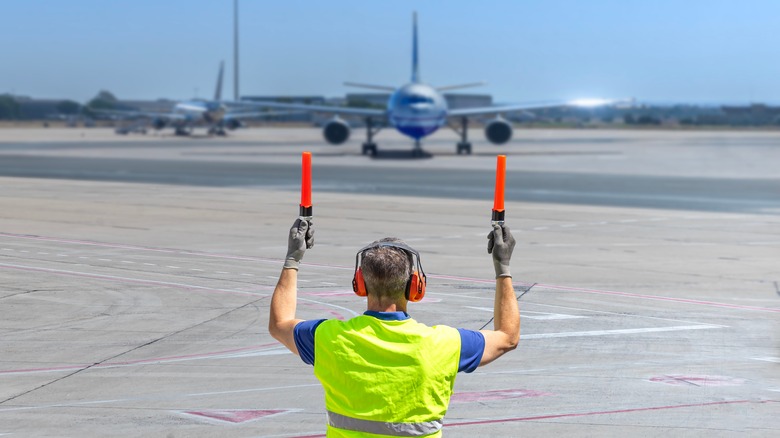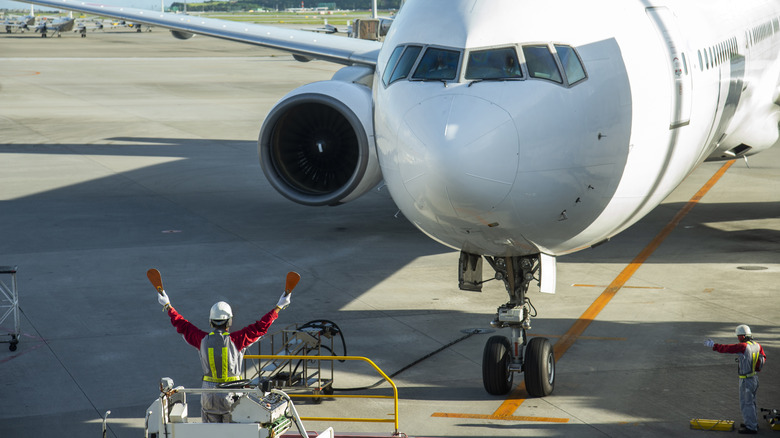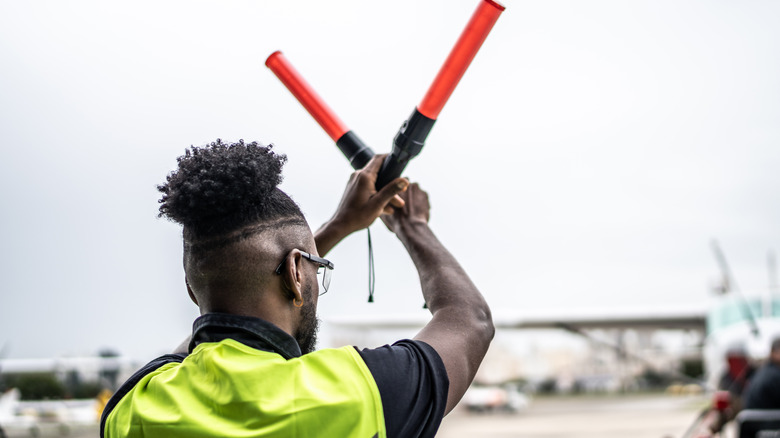
It's a defining part of any airport experience, watching staff wave the wands in front of the planes as they prepare for take off. Considering how much careful planning and coordination must go into running an airport, it's not surprising to hear that this is actually a special language known as aircraft marshalling. These highly trained professionals act as the plane's eyes on the ground. The signals they send help pilots safely maneuver their massive, multi-ton machines through tight and crowded
spaces on the runway.
From private jet airports (or FBOs) to the largest international hubs, marshallers are an incredibly important part of airline safety. It's why the job demands sharp focus, strong situational awareness, and a vast knowledge of both aviation protocols and airport layouts. But what exactly do those movements mean when a marshaller is waving those lights around?
One of the most common signals is "Straight Ahead": the marshaller bends both arms at the elbows and moves the wands up and down from chest to head, directing the pilot to continue taxiing in a straight line. Another frequent signal is "Turn Left" or "Turn Right," where one arm moves in the direction the aircraft should pivot while the other makes a "come ahead" motion.
Read more: 10 Of The Fastest Civilian Helicopters, Ranked By Top Speed
What Are Some Of The Most Common Aircraft Marshalling Signals?

All these movements can be confusing at first glance, especially for beginner pilots, but the general rule of thumb is really simple: just follow the extended arm. When the aircraft reaches its parking spot, the marshaller will throw out the "Normal Stop" signal, where they extend their arms outward and raise them until the wands cross above the head. If the aircraft needs to slow down before reaching that spot, the marshall will do a "patting" motion with both arms directed downward. These movements must be crystal clear and unmistakable, whether they're directing the largest plane currently flying or the smallest.
Of course, marshallers don't just guide planes into position. They also let pilots know when it's safe to start or shut down engines, and when chocks (wedges placed under the wheels) should be inserted or removed. For example, to start an engine, the marshaller points to the designated engine while spinning a wand in a circular motion. To shut engines down, they use a clear "cut throat" gesture by moving the wand from one shoulder across to the other.
Why Aircraft Marshalling Is So Important

Aircraft marshalling gestures are standardized by organizations like the International Civil Aviation Organization (ICAO) and the International Air Transport Association (IATA). Standardizing them helps ensure clear communication across the tens of thousands of airports worldwide and even military use cases, like with U.S. Air Force ground crews and their hand signals.
Despite the rise of advanced aircraft systems, the human element of aircraft marshalling remains irreplaceable, especially in high-risk or low-visibility conditions. Not to mention, not every airport is equipped with the latest and greatest tech. And even at major airports, communication radios can falter. In smaller regional airports or during temporary equipment failures, marshalling is what pilots have to rely on.
In every one of these scenarios, the aircraft marshaller's visual cues become a backup safety net. They prevent any major misunderstandings that could lead to expensive, dangerous, or even deadly errors. It's why the role of a marshaller is also critical in emergency scenarios: Whether directing emergency vehicles during an evacuation or helping re-route aircraft when runways are congested, their ability to deliver fast, visual commands can make the difference between mass chaos and coordination.
Want the latest in tech and auto trends? Subscribe to our free newsletter for the latest headlines, expert guides, and how-to tips, one email at a time.
Read the original article on SlashGear.











